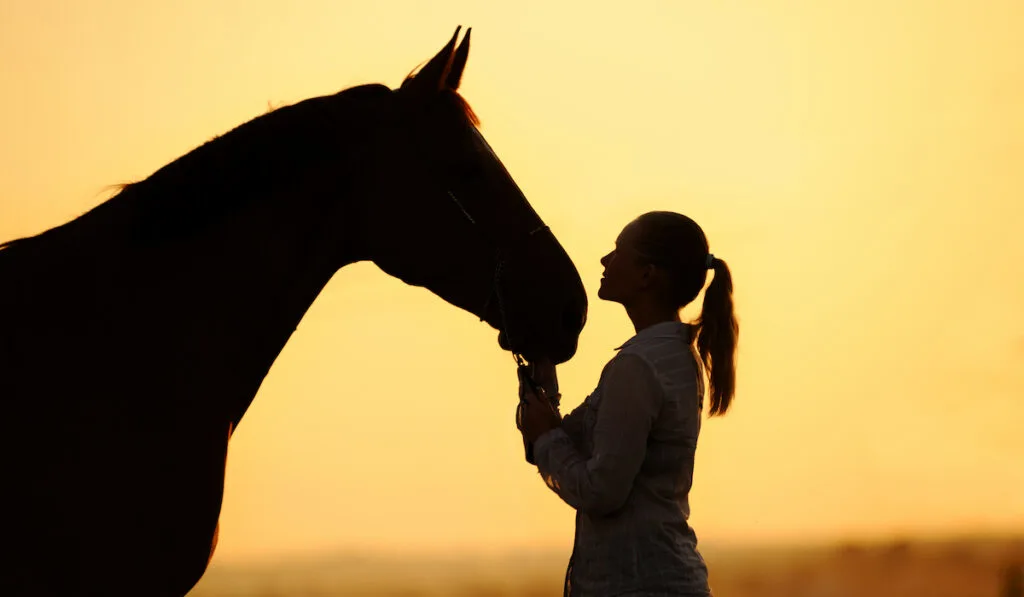Some of the most popular and versatile horses don’t have purebred pedigrees. Horses with unknown parentage or a significant amount of mixed breeding are called grade horses. However, many mixed-breed horses are deliberate crosses between two (or more!) purebred breeds. Here are 13 types of popular mixed breed horses.

Table of Contents
1. Anglo-Arab
Arabian x Thoroughbred
Anglo-Arabs are athletic horses bred for equestrian competition. With the speed of a Thoroughbred and the stamina of an Arabian, these horse excel at events like show jumping and eventing.
While Anglo-Arabs can range in size and type, they are generally taller and less refined than the average purebred Arabian. To be registered in a special section of the Arabian registry, Anglo-Arabs must be at least 12.5% Arabian.
2. Appendix
Thoroughbred x Quarter Horse
An Appendix horse is a first-generation cross between a registered Quarter Horse and a registered Thoroughbred. These athletic horses are the “best of two breeds,” according to the American Appendix Horse Association.
Both Thoroughbreds and Quarter Horses are known for their speed– Thoroughbreds excel over longer distances and Quarter Horses dominate in short bursts.
Appendix horses are often found in competitive rodeo events, such as barrel racing, cutting, and reining. They also make good ranch horses, as well as overall pleasure mounts.
These pedigreed mixed-breed horses may be registered with the American Quarter Horse Association as an Appendix, as long as both parents are registered with the AQHA and the Jockey Club.
An Appendix horse that performs well in competition may be eligible to become a “full” Quarter Horse with a “Registration of Merit.”
3. ArAppaloosa (Araloosa, Arappaloosa, Ara-Appaloosa)
Arabian x Appaloosa
Both the Arabian and the Appaloosa excel in endurance events, and the ArAppaloosa gets the best of both worlds from its parents.
Known for their unique looks, the ArAppaloosa usually has the Appaloosa’s spotted coat (thanks to the leopard-complex gene) and the Arabian’s refined body type.
AraAppaloosas may be registered with the Appaloosa Horse Club, or as a “part-bred Arabian” with the Arabian Horse Association. They also may become registered Sportaloosas (Appaloosa Sporthorses) as well.
4. Desert Norman Horse
Arabian x Percheron
The athletic Desert Norman Horse represents an early form of the Percheron draft horse breed – refined and elegant, yet powerful and athletic.
These horses excel at driving and light farm work, but often compete in jumping and dressage as well. The Desert Norman Horse must be at least 25% Arabian or 25% Percheron, with no other breeds included.
5. Irish Draught Sporthorse
Irish Draft x Thoroughbred
The Irish Sporthorse is a breed of warmblood that is popular for use in dressage, eventing, and show jumping. Strong and powerful, Irish Sporthorses get their speed and endurance from their Thoroughbred parentage, and their strength and good temperament from the Irish Draft.
The Irish draft was a popular and versatile farm horse in the early 20th century. Used for riding, hunting, driving, and light farm work, these horses could do it all. As mechanization became more popular on small farms, equestrian activities became focused on recreation and sport.
Breeders began crossing Irish Drafts with Thoroughbreds to produce quality competition horses. In North America, an Irish Draft Sporthorse must have at least one registered parent to become a registered Irish Draft Sporthorse.
6. Morab
Morgan x Arabian
While breeders have always crossed Morgans and Arabians to produce versatile trotting horses, the official beginnings of the Morab breed began in the 1850’s with a mixed breed named Golddust.
The progeny of a Morgan stallion and an Arabian mare, Golddust sired over 300 quality foals.
Today, the Morab is not just a mixed breed horse, but it’s a breed itself in its own right. Morabs are excellent at driving, endurance, trail riding, jumping, and ranch work.
To be registered with the Morab Association, a Morab may be no more than 75% and no less than 25% of either Morgan or Arabian.
Other breeds are not allowed in the mix, and the Purebred Morab Horse Association only accepts animals with solid coloring and no white above the hocks.
7. National Show Horse
American Saddlebred x Arabian
The National Show Horse is just that – a horse bred specifically for the show ring. American Saddlebreds and Arabians have always performed well in saddle seat competitions, and the National Show Horse possesses excellent qualities from both breeds.
They have a refined build, display excellent motion in their gaits, and attract attention in the show ring. They’re also excellent pleasure and trail mounts as well.
National Show Horses must have parents that are registered as some combination of American Saddlebred, Arabian, or National Show Horse, as long as the resulting foal has at least 25 – 99% Arabian blood.
8. North American Spotted Draft Horse
Belgian, Percheron, Clydesdale, Suffolk Punch, Shire, American Cream Draft
Spotted draft horses have been popular throughout history, often serving as drum horses in medieval times. In the 1960s, a concerted effort was made to create a registry for these uniquely colored horses, and preserve their heritage.
North American Spotted Draft horses can be any mixture of draft horse – Belgian, Percheron, Clydesdale, Suffolk Punch, Shire, and American Cream Draft.
Percherons are popular choices, as they have a tendency to throw foals with the pinto coloring. As long as the foal displays a flashy spotted coat and has draft blood breeding (and no Gypsy Vanner, Saddlebred, or Appaloosa), they can be registered with the North American Spotted Draft Horse Association.
9. Quarab
Quarter Horse or American Paint Horse x Arabian
The American Quarter Horse allows a registration of merit to Quarter Horse crosses that successfully perform in the competition arena.
Crosses between Quarter horses and Arabians have always been popular, but the Quarab is a particular blend known for its versatility and athleticism.
Quarabs perform well in rodeo events, on the trail, or in English hunter events as well. To be registered with the International QuaRab Horse Association, a foal must have at least 1/8ths blood from both Arabian and stock horse types.
10. Welara
Welsh Pony x Arabian
Lady Wentworth, a prominent Arabian breeder in England, began crossing Welsh ponies and Polish Arabians in the 1920s. The result was a small athletic riding and driving horse perfect for children and small adults.
A purebred Welara registered with the American Welara Pony Registry must have at least 1/8th and no more than 7/8ths blood from Welsh Pony or Arabian bloodlines.
There are also various height requirements, but Welaras can be registered as Welara Sport Ponies if they fall outside of these requirements. They may also be registered as a Welara Sport Pony if they are a mixed breed with at least 50% Welara blood.
11. Warlander
Friesian x Andalusian, Lusitano, or Menorquina
Breeders have been crossing Friesians and Iberian horses for decades, but a concerted effort was made in the 1990s to begin breeding these specific “super horses.”
“The ideal Warlander combines the Iberian horse’s intelligence, facility for collection, flexibility, and powerful hindquarters, with the Friesian’s tractability, dramatic leg action, ‘bone,’ and strong forequarters.” (source)
Especially popular for upper level dressage, the Warlander is willing and trainable. A registered Warlander must not be more than 75% and not less than 25% purebred Friesian or Iberian. (source)
12. Warmbloods
Many warmblood registries allow crossbreeding to other breeds such as Thoroughbreds or Arabians. Warmblood studbooks are often open, which means that outside mares and stallions are allowed to be bred and produce a registered foal.
Warmblood breeders are generally focused on producing animals who will excel in competition, and less focused on maintaining specific pure bloodlines. Breeders select for movement and conformation, based on how they want the horse to perform in its chosen discipline.
Here is an example of some warmblood breeds that may have mixed parentage:
| Open Studbook | Selectively Open Studbook | Closed Studbook |
| Dutch Warmblood | Hanoverian | Trakhener |
| Oldenburg | Holsteiner | |
| Westphalian, Rhinelander | ||
| Other German Warmbloods | ||
| Belgian Warmblood | Selle Francais | |
| Swiss Warmblood | ||
| Danish Warmblood | ||
| Finnish Warmblood | ||
| Swedish Warmblood | ||
| American Warmblood |
13. Sporthorses
Like warmbloods, sporthorses are bred for competition. Some of these crossbreeds have their own registries, but breeders are less focused on maintaining pure bloodlines and more focused on producing top-performing competitors.
The Friesian Sporthorse, for example, is a type of Friesian crossbreed that is suitable for eventing, dressage, show jumping, and combined driving. Purebred Friesians generally excel at dressage, but Friesian Sporthorses can be more versatile.
Another example is the Sportaloosa, which is a registered spotted sporthorse. Many registries prohibit spotted coloring or Appaloosa genes, but Spotaloosas are crosses between an Appaloosa and other sport horse breeds (mostly Thoroughbred and Quarter Horse).
Other Breeds that Allow Outcrosses
Some breed registries (such as Friesians and Thoroughbreds) do not allow any outside bloodlines to be introduced. However, many breeding studbooks allow the infusion of other breeding genes, which often causes the resulting foals to have more desirable traits.
Here are some examples of breeds that allow registerable crosses:
| Breed | Crossbreeds Allowed |
| Colorado Rangerbred | Thoroughbred, Quarter Horse, Appaloosa, ArAppaloosa |
| Selle Francais | Thoroughbred, French Trotter, Arabian, Anglo-Arab |
| American Paint Horse | Quarter Horse, Thoroughbred |
| American Quarter Pony | Quarter Horse, American Paint Horse, Appaloosa, Pony of the Americas |
| Appaloosa | Quarter Horse, Thoroughbred, Arabian |
| Hanoverian | Thoroughbred, Anglo-Arabian, Arabian |
| Pony of the Americas | Quarter Horse, Arabian, Connemara, Galiceno, Australian Palouse, Morgan, Thoroughbred, Quarter Pony, Welsh Pony, Anglo-Arab, Spanish Mustang, Half-Arab, Shetland |
| Curly Horse | Arabian, Morgan, Appaloosa, Missouri Fox Trotter, Mustang |
At the end of the day, bloodlines aren’t the only thing that matters when it comes to finding a quality horse. Even the most mixed-breed grade horse can perform at top levels in competition, with the right training and handling.

